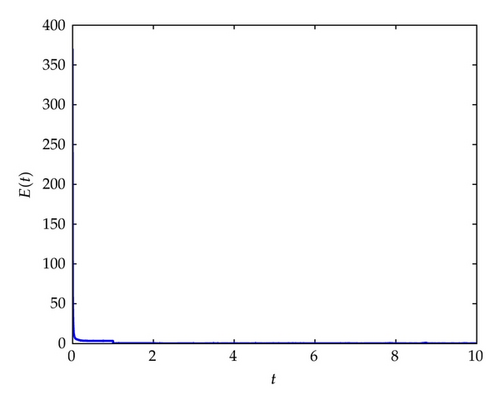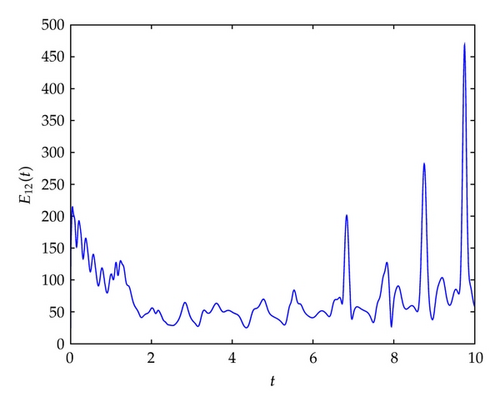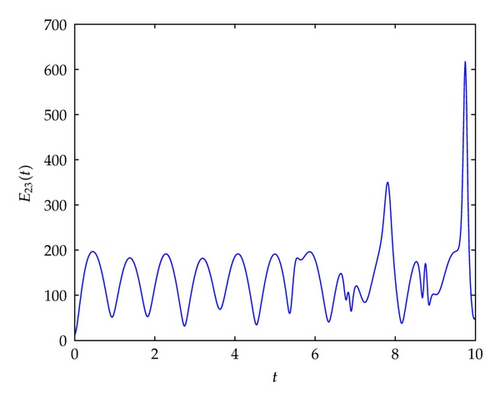Cluster Synchronization of Time-Varying Delays Coupled Complex Networks with Nonidentical Dynamical Nodes
Abstract
This paper investigates a new cluster synchronization scheme in the nonlinear coupled complex dynamical networks with nonidentical nodes. The controllers are designed based on the community structure of the networks; some sufficient criteria are derived to ensure cluster synchronization of the network model. Particularly, the weight configuration matrix is not assumed to be symmetric, irreducible. The numerical simulations are performed to verify the effectiveness of the theoretical results.
1. Introduction
Complex networks model is used to describe various interconnected systems of real world, which have become a focal research topic and have drawn much attention from researchers working in different fields; one of the most important reasons is that most practical systems can be modeled by complex dynamical networks. Recently, the research on synchronization and dynamical behavior analysis of complex network systems has become a new and important direction in this field [1–13]; many control approaches have been developed to synchronize complex networks such as feedback control, adaptive control, pinning control, impulsive control, and intermittent control [14–21].
Cluster synchronization means that nodes in the same group synchronize with each other, but there is no synchronization between nodes in different groups [22–25]; Belykh et al. [26] investigated systems of diffusively coupled identical chaotic oscillators; an effective method to determine the possible states of cluster synchronization and ensure their stability is presented. The method, which may find applications in communication engineering and other fields of science and technology, is illustrated through concrete examples of coupled biological cell models. Wu and Lu [27] investigated cluster synchronization in the adaptive complex dynamical networks with nonidentical nodes by a local control method and a novel adaptive strategy for the coupling strengths of the networks. Ma et al. [28] proposed cluster synchronization scheme via dominant intracouplings and common intercluster couplings. Sorrentino and Ott [29] studied local cluster synchronization for bipartite systems, where no intracluster couplings (driving scheme) exist. Chen and Lu [30] investigated global cluster synchronization in networks of two clusters with inter- and intracluster couplings. Belykh et al. [31, 26] studied this problem in 1D and 2D lattices of coupled identical dynamical systems. Lu et al. [32] studied the cluster synchronization of general networks with nonidentical clusters and derived sufficient conditions for achieving local cluster synchronization of networks. Recently, Wang et al. [33] considered the cluster synchronization of dynamical networks with community structure and nonidentical nodes and with identical local dynamics for all individual nodes in each community by using pinning control schemes. However, there is few theoretical result on the cluster synchronization of nonlinear coupled complex networks with time-varying delays coupling and time-varying delays in nonidentical dynamical nodes.
Motivated by the above discussions, this paper investigates cluster synchronization in the nonlinear coupled complex dynamical networks with nonidentical nodes. The controllers are designed based on the community structure of the networks; some sufficient criteria are derived to ensure cluster synchronization in nonlinear coupled complex dynamical networks with time-varying delays coupling and time-varying delays in dynamic nodes. Particularly the weight configuration matrix is not assumed to be symmetric, irreducible.
The paper is organized as follows: the network model is introduced followed by some definitions, lemmas, and hypotheses in Section 2. The cluster synchronization of the complex coupled networks is discussed in Section 3. Simulations are obtained in Section 4. Finally, in Section 5 the various conclusions are discussed.
2. Model and Preliminaries
The study presents the mathematical definition of the cluster synchronization.
Let {C1, C2, …, Cm} denote m (2 ≤ m ≤ N) communities of the networks and If node i belongs to the jth community, then we denote ϕi = j. We employ fi(·) to represent the local dynamics of all nodes in the ith community. Let si(t) be the solution of the system where lim t→∞ ∥si(t) − sj(t)∥ ≠ 0 (i ≠ j); the set S = {s1(t), s2(t), …, sm(t)} is used as the cluster synchronization manifold for network (2.3). Cluster synchronization can be realized if and only if the manifold S is stable.
Definition 2.1 (see [19].)The error variables as for i = 1,2, …, N, where satisfies .
Definition 2.2 (see [19].)Let {1,2, …, N} be the N nodes of the network and {C1, C2, …, Cm} be the m communities, respectively. A network with m communities is said to realize cluster synchronization if lim t→∞ei(t) = 0 and lim t→∞∥xi(t) − xj(t)∥ ≠ 0 for ϕi ≠ ϕj.
Lemma 2.3. For any two vectors x and y, a matrix Q > 0 with compatible dimensions, one has 2xTy ≤ xTQx + yTQ−1y.
Assumption 2.4. For the vector valued function , assuming that there exist positive constants such that f satisfies the semi-Lipschitz condition
Assumption 2.5. and is a differential function with and . Clearly, this assumption is certainly ensured if the delay and is constant.
Assumption 2.6 (34) (Global Lipschitz Condition). Suppose that there exist nonnegative constants ϑ, β, for all t ∈ R+, such that for any time-varying vectors x(t), y(t) ∈ Rn
3. Main Results
Theorem 3.1. Suppose assumptions 2.4–2.5 hold. Consider the network (2.1) via control law (3.3). If the following conditions hold:
Proof. Construct the following Lyapunov functional:
We can conclude that, for any initial values, the solutions x1(t), x2(t), …, xN(t) of the system (2.3) satisfy , that is, we get the global stability of the cluster synchronization manifold S. Therefore, cluster synchronization in the network (2.3) is achieved under the local controllers (3.3). This completes the proof.
Corollary 3.2. When A = 0, network (2.1) is translated into
We design the controllers, as follows, then the complex networks can also achieve synchronization, where
Corollary 3.3. When B = 0, network (2.1) is translated into
We design the controllers, as follows, then the complex networks can also achieve synchronization, where
4. Illustrative Examples




5. Conclusions
The problems of cluster synchronization and adaptive feedback controller for the nonlinear coupled complex networks are investigated. The weight configuration matrix is not assumed to be symmetric, irreducible. It is shown that cluster synchronization can be realized via adaptive feedback controller. The study showed that the use of simple control law helps to derive sufficient criteria which ensure that nodes in the same group synchronize with each other, but there is no synchronization between nodes in different groups is derived. Particularly the synchronization criteria are independent of time delay. The developed techniques are applied three complex community networks which are synchronized to different chaotic trajectories. Finally, the numerical simulations were performed to verify the effectiveness of the theoretical results.
Acknowledgments
This research is partially supported by the National Nature Science Foundation of China (no. 70871056) and by the Six Talents Peak Foundation of Jiangsu Province.




